Thursday, September 23rd at 11:00 AM ET
Nulla ut nisl a tellus pretium efficitur
News and Insights
• March 31, 2022
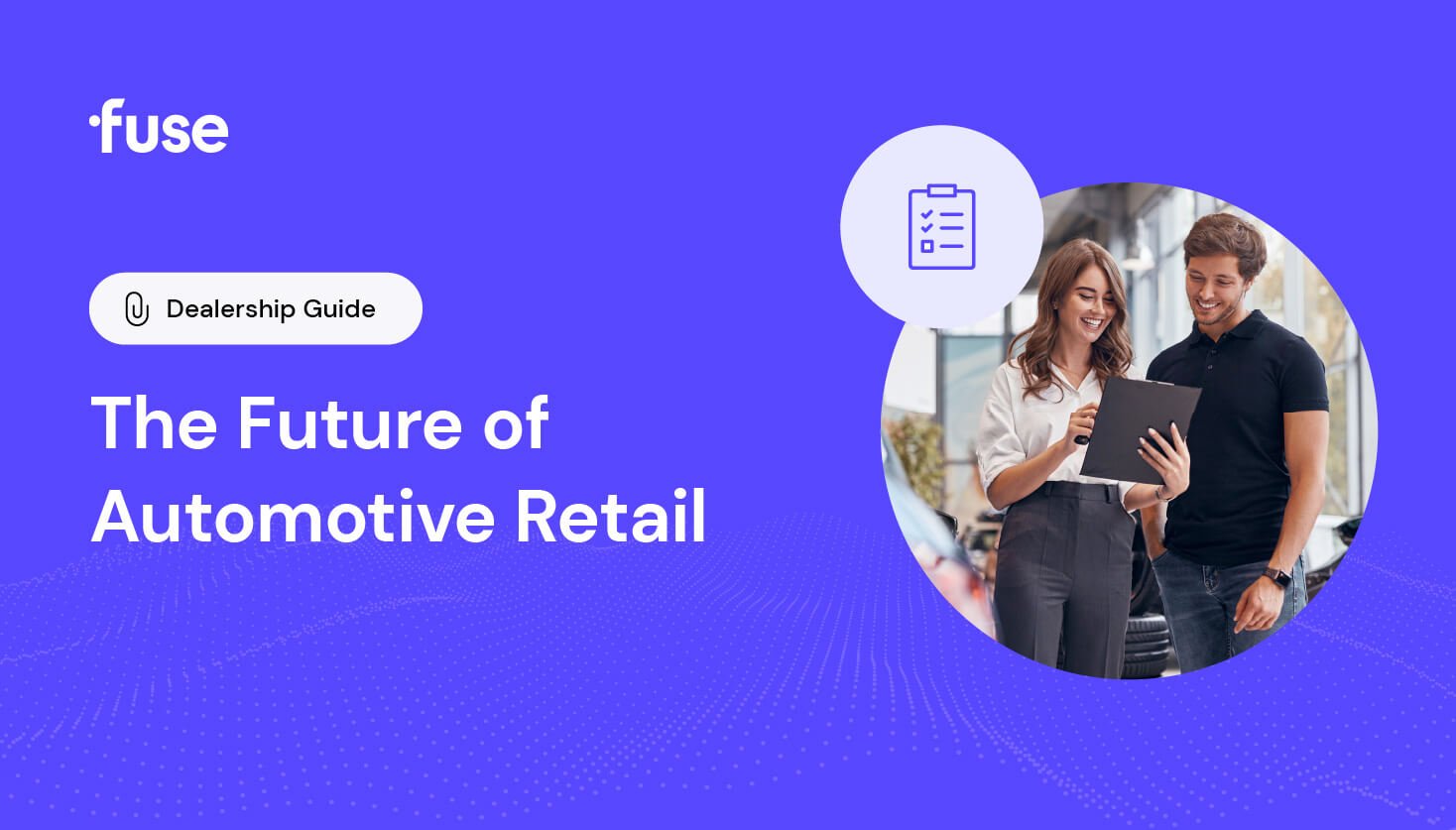

By: Tom Ryan
10 minute read
Today’s electric and hybrid cars appear nearly unrecognizable when compared to the first gas-powered car models created in the 1880s. The same cannot be said for the actual process of buying a car—which remains mostly the same even after all this time. While technological, cultural, and societal shifts have impacted the traditional dealership model, much of the car selling process remains unchanged.
As more people seek the option to purchase vehicles online, car dealership owners and general managers (GM) must begin the process of considering how the traditional car purchasing journey needs to evolve to meet customer expectations.
In this article, we’re digging into the history of car dealerships. We’ll also be exploring what’s on the horizon for the industry overall—and perhaps most importantly—how car dealerships can prepare to meet shifting customer expectations.
The first car sale dates back to the 1880s when Karl Benz (of Mercedes Benz) designed a gas-powered vehicle known as the Motorwagen. This is one of the first recorded—if not the first—vehicle of its kind.
Benz sold around 25 Motorwagens throughout the late 1880s and 1890s, but by 1903, demand had increased and approximately 60,000 automobiles were produced each year.
Initially, auto manufacturing factories were responsible for selling cars. But this system had clear disadvantages—buyers had to either live near a factory or organize the delivery of the vehicle.
Take for example, the Ford Motor Company’s first car sale. On July 15, 1903, Ford sold an $850 two-cylinder Model A to Chicago dentist Ernst Pfenning. Pfenning ordered the car from the factory and one week later, the company delivered it to his home in Chicago, Illinois.
The car selling model began to shift when Fred Koller opened the first dedicated car dealership in 1889. Known as the Reading Automobile Company, Koller sold cars manufactured in Cleveland, Ohio at his dealership in Reading, Pennsylvania. This is thought to be the first dealership dedicated solely to selling cars—meaning it hadn’t initially been established to sell horse-drawn carriages.
Koller sold Winton automobiles that ranged in price from around $1,800 to $4,500 each, which today would be equivalent to approximately $50,000 to $124,000.
Both World War I and World War II caused a slump in car manufacturing and purchasing. Wartime rationing and the need to conserve metals for weaponry purposes resulted in the halt and near grounding of the United States auto industry. Although some manufacturers experienced success making vehicles for the war, consumer sales were greatly reduced.
On top of that, the Great Depression removed the ability for most people to purchase a car. American consumers simply did not have the funds required to make a large purchase.
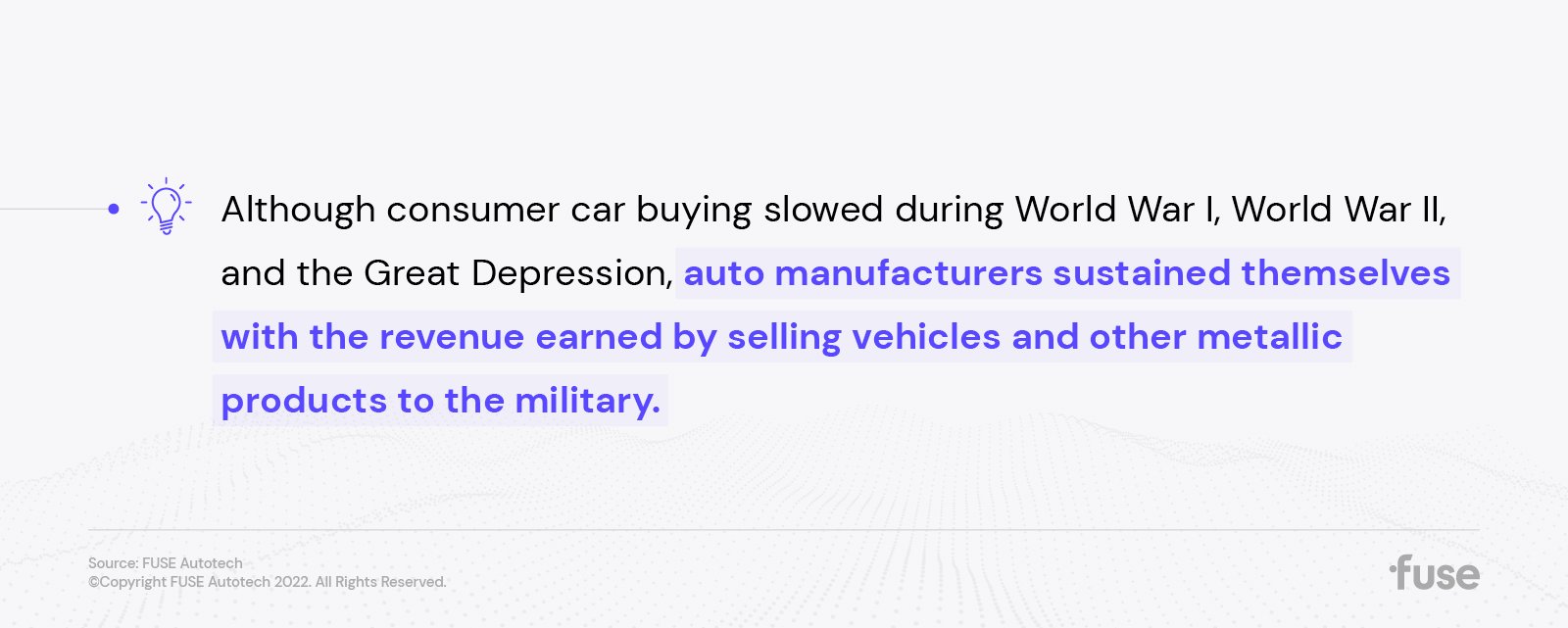
In 1942, the U.S government froze the sale of consumer vehicles. Auto manufacturers had to concentrate on making tanks, airplanes, Jeeps, trucks, torpedoes, and helmets. Many of today’s top car manufacturers had a hand in producing vehicles for the military during the World Wars.
Although consumer car buying slowed during this time, auto manufacturers sustained themselves with the revenue earned by selling vehicles and other metallic products to the military.
After World War II, returning soldiers and families had more money and increased spending power. People were eager to buy homes, appliances, and cars. This led to an overall boom in manufactured items.
The American public’s excitement for cars created demand for new features and innovations in civilian vehicles. After automotive factories were permitted to cease production of wartime materials, carmakers began building models that showcased new, better options for consumers. Post-war vehicles sported large tail fins and chrome detailing. For the first time ever, cars could be started with the turn of a key and the automatic transmission debuted making vehicles easier and safer to operate. With the popularity of cars at an all-time high, car dealerships began springing up across the country.
Up until this point, dealer owners had the freedom to manage business as they saw fit. There were no regulations in place surrounding how vehicles were to be priced or how they needed to be sold to customers. However in 1958, senator Almer Stillwell Monroney ushered in legislation requiring car dealers to place stickers on their vehicles that listed out the recommended price as well as detailed vehicle specifications.
This was the first legislation of its kind, designed to protect and inform customers engaged in the car buying process.
Vehicle sales for new cars held strong throughout the 1960s alongside used car sales which also grew in popularity. Cars from the 1950s and 1960s can still be found on the road today, in part due to the high production numbers that occurred during these decades.
As a result of increasing gasoline prices, cars became more expensive to manufacture and to run in the early 1970s. With that sudden spike, consumer demand for vehicles began to fall. Car manufacturers responded by reducing the quantity of models running through production lines.
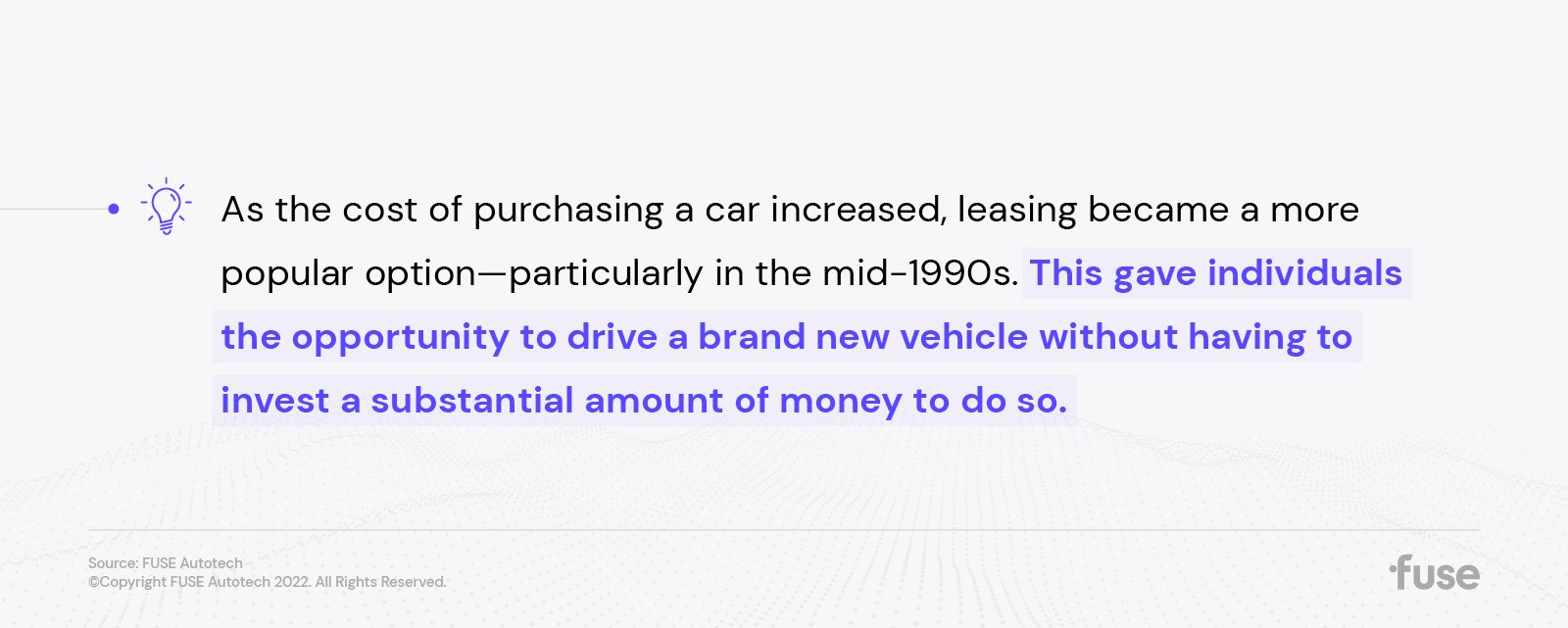
It wasn’t that people didn’t want to buy cars, they just needed an affordable way to own one. As a result, consumers began looking for options that offered better gas mileage. Consequently, European and Japanese vehicles rose in popularity due to being smaller in size and less expensive to operate compared to larger American models.
As the cost of purchasing a car increased, leasing became a more popular option—particularly in the mid-1990s. This gave individuals the opportunity to drive a brand new vehicle without having to invest a substantial amount of money to do so.
The traditional transactional car dealership model remains largely unchanged since Koller opened the first dealership more than 120 years ago.
While most American consumers research different vehicle models and package options on third-party websites prior to visiting a dealership, car buyers will still visit their neighborhood dealership to take a test drive and explore different financing options.
Ten years ago, very few people would have considered buying a car online. Today, online car dealerships have become increasingly common.
The COVID-19 pandemic has accelerated this shift to online car sales. Alan Haig, an automotive retail consultant and president of Haig Partners, found that 30% of U.S. new car sales in 2021 were completed online. For comparison, less than 2% of vehicles were purchased digitally prior to the pandemic.
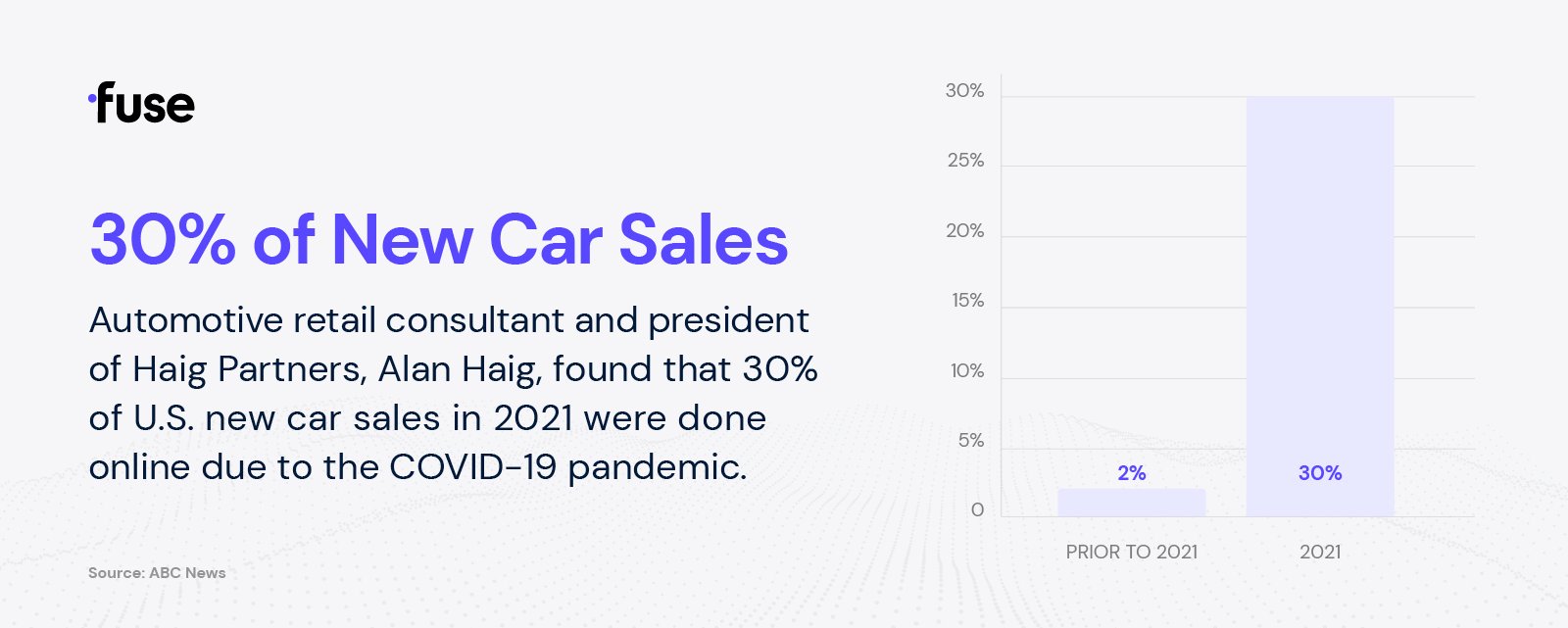
Online car retailers like Carvana and Vroom have experienced large increases in sales in the last couple of years. Carvana, for instance, sold 244,111 cars in 2020—up 37% from 2019.
Due to evolving customer expectations for online purchasing and changes accelerated by the pandemic, many dealerships are experiencing a shift. Rather than the occasional online sale, the majority of customers are initiating or finalizing their purchase online.
>> Download the Guide - Driving Dealership Customer Satisfaction and Profits with the Modern Retail Approach
In addition to pandemic-related trends, factors related to customer experience are igniting changes in automotive retailing.
Unfortunately, many people report that the experience of visiting a dealership is stressful and uncomfortable. A chief complaint being the length of time required to complete the necessary paperwork. According to our research, it takes three hours, on average, to complete the purchasing paperwork—with more than half of that time spent negotiating.

In a survey to uncover the importance of customer experience in the automotive space, McKinsey & Company found that 48% of respondents view customer experience as “influential” in their purchasing decision. Twenty-two percent of those people say it is “very influential.”
In today’s uncertain world—chip shortages and other vehicle-related supply chain issues are common. Perhaps more than ever before, it’s vital for dealership owners and GMs to double-down on the factors they can control. For this reason, we turn now to consider what the future holds for the car dealership business model and how dealers can prepare for long-term success.
Nearly every retail and service-based company has made the leap into eCommerce. Dealerships have an opportunity to improve the customer experience through business process transformation and the deployment of supporting technologies. Now is the time for dealerships to get serious about overhauling the retail experience for car buyers.
Ultimately, people want two things when they set out to purchase a vehicle—convenience and simplicity. While some consumers opt for an online-only car buying experience, the majority still want the personalized, human touch that only a local dealership can deliver.
Looking ahead, car dealerships need to unearth new ways of leveraging digital tools while simultaneously providing an up-leveled, in-person, modern customer experience.
While tech seems poised to upend the car dealership model as we know it, there is a path forward for a complementary relationship between modern technology and traditional dealerships. Zillow, for example, hasn’t eliminated realtors from the home buying process. Rather, it effectively removed a lot of the initial busywork realtors are tasked with when engaging with clients. Home buyers still want that personal, concierge-level service along with their realtor’s expert knowledge regarding the complexities of the home-buying process.
This hybrid model represents the best of how online digital retail systems and the in-person experience can be merged to everyone’s benefit. This model fits very closely to how the car dealership model can work today.
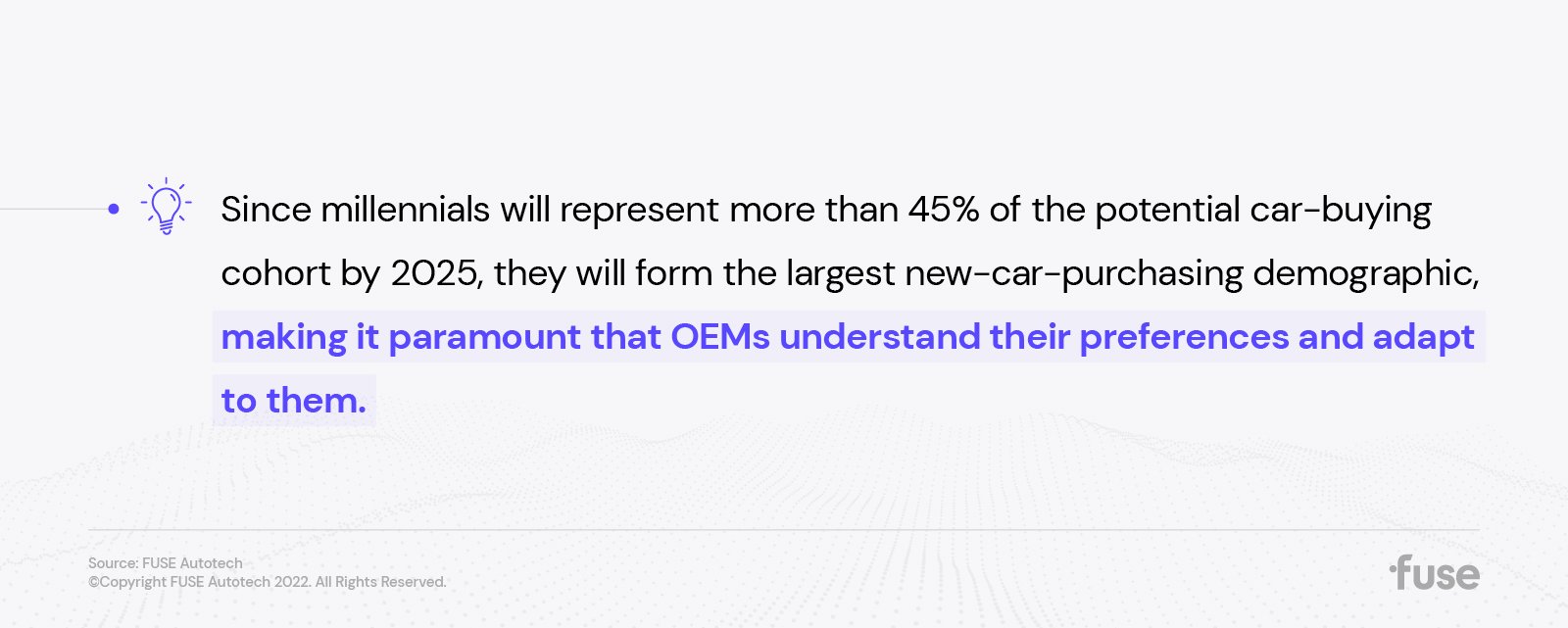
It is also important to consider which demographics are most likely to purchase cars. According to McKinsey & Company, Millennials (those born between 1981-1996, or 26-41 years old in 2022) will represent more than 45% of the potential car-buying cohort by 2025.
“They will thereby form the largest new-car-purchasing demographic, making it paramount that OEMs understand their preferences and adapt to them.” - McKinsey & Company.
Unfortunately for car dealers, one survey reveals that Millennials would prefer to wait in line at the DMV or do their taxes rather than have to visit a car dealership. Additionally, Gen X respondents report they would rather get a root canal than negotiate with a car dealer.
It is clear that a gap exists between what customers expect when visiting a car dealership and what they actually experience.
Car dealers that prioritize researching and understanding its key demographics will have more success bridging this gap.
A Volvo spokesperson told ABC News that "our retail partners will remain an integral part of our sales and customer care process" and there are "no plans to close any retailers within our network."
>> Sign Up for Email Updates - Get Great Content Like This Delivered Right to Your Inbox
Here are a few ways car dealerships can put the excitement and positive sentiments back into car buying:
The future of automotive retail will be shaped, led, and won by dealerships that prioritize efficiency—in both customer-facing and behind-the-scenes operations. The time is now to implement technology solutions that enable streamlined, in-store experiences for customers and an efficient model for internal operations.
Ready to improve customer experience at your dealership?
>> See How Fuse Transact Works - Watch the Video Now

Do you regularly find yourself advertising job roles to fill in where employees have left? With long working hours and a high-pressure environment centered around demanding sales targets, it’s easy...
News and Insights
8 min read

No matter what business you’re in, customer retention is vital and challenging. This is particularly the case when it comes to car dealerships. After all, purchasing a car is not a weekly necessity...
News and Insights
10 min read

The secret is out: data drives our digital economy. While that’s true across all sectors, data is especially valuable in the automotive industry. The dealers who embrace data will be best positioned...
News and Insights
16 min read